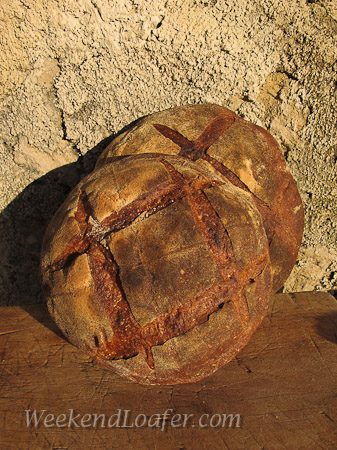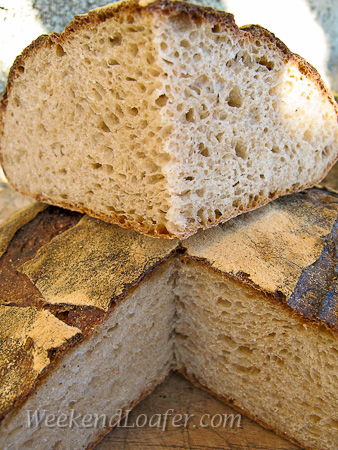
An Experiment – Miche with high extraction wheat, spelt, quinoa and a smidgen of rye

With my bread supply almost depleted and my neighbors arriving for their monthly visit to there retreat… I charged up my stiff Levain and was ready to conquer another recipe from Local Breads for my weekly bread. I thumbed through the chapter with stiff dough levain recipes and to my complete surprise, I baked them all! I did not have time to convert the waiting stiff levain to a liquid one…so I went into the pantry to inventory my baking supplies and discovered I had lots of high extraction flour, spelt and an unopened bag of quinoa (never used it before in pain). And with that the experiment was on. The first thing that came to mind was a giant Poilane-inspired Miche with mixed flours …. while the other side of my brain was saying “try something sure-fire, something to share with your neighbors.” Well -- throwing caution to the wind -- I went for the Miche! I wrote out the recipe and doubled it substituting some (approx. 1/3) of the whole wheat flour for the spelt and quinoa…and then adding a smidgen of rye. After an hour of antolyse, and another 15 minutes of slapping and smearing a very slack dough into workable dough, I took a breather and wiped the sweat for my brow.
When I returned to my experiment rejuvenated by a good cup of strong French style coffee, I uncovered the dough to find the once taut boule was now, shall we say, relaxed and spread out on the counter . . . ugggh. As I started to panic I heard a voice in my head saying “you can never over knead a dough by hand”. So I continued the French kneading for another ten minutes, did a window pane test, and it passed the test! I threw the still slack dough into a bowl for one hour to ferment, crossed my fingers and hung my laundry out to dry. After two series of stretch and folds in the bowl, I covered it back up and put it into the 76° proofing chamber for two hours before shaping. Shaping the slack dough into a miche was a little more artful than I had planned for…but these loaves gently made their way into the linen lined bowl and banneton for the final two hour proofing. And that was my big mistake!
When I finally looked in after two hours, it had more than doubled and looked like a pillowy, bowl of loose Jell-O full of air bubbles. Because of the size of the boules…and the size of my oven…I put the smaller one in the fridge to slow things down, and gently turned the other out onto a piece of parchment paper, slashing it swiftly with four crossing lines. The only thing that comes to mind when trying to describe the sensation of slashing the miche, is the feeling you have when running over a nail on your bike…first you hear the pop and then you see it slowly deflate. Sound familiar?
Feeling a bit deflated myself…I placed the miche in the awaiting, steamy oven for its trial by fire! As I peered through the glass of the oven door, I was a bit relieved to see the loaf making a bit of a comeback. Although it did have a little oven spring, it wasn’t what I was hoping for. Though it wasn’t a pancake, let’s just say it had a low profile, something more similar to a Pointe-à-Callière Miche! After baking the other loaf and letting it cool, I cut into the small loaf to see the outcome. The tan crumb was riddled with small even bubbles, the crust was crisp and brittle….and the taste was even better than I expected. It had a very moist, creamy mouth feel with a bit of a tang, but not too much for my French neighbors' pallets …they really enjoyed it. I will be very curious to see how the flavor transforms over the next couple of days of eating. This is one I definitely will have to revisit again!

Thing to remember next time:
- Try pre-fermenting some of the spelt and quinoa...
- Hold back some of the water in the initial mix (I knew that), you can always add it to get the necessary consistency.
- May be leave out the autolyse?
- Either lower the temperature for the final proofing or cut it back to one hour.
- AND: DO NOT TAKE A NAP DURING THE FINAL PROOFING!
If you want to see the recipe and MORE pictures...you are just a click away... Weekendloafer.com


Comments
I don't see a thing wrong with your crumb photo, looks perfect. The cells are well distributed and even, top to bottom. Very nice. It doesn't look a bit over proofed to me.
Eric